
Sunrise at about 6:30. When my students woke up I asked them if they wanted to see the sunrise. Then I showed them the picture on the computer.
Middle and High School … from a Montessori Point of View

We’re off to Heifer International again with a new crop of middle-schoolers. This time Ms. Vranas is the other chaperone.
With stopping for lunch, stopping for gas, and stopping by a grocery to pick up supplies, the trip out lasted over 8 hours, but we made it out with everyone in good humor. The kids played Head’s Up Seven Up, and their own stashes of snack food.
I use these trips to introduce geology, specifically the dynamics of mountain-building and erosion using the Ozarks as an example. So every time we passed an outcrop (of which there were quite a number) I pointed it out and one of the students would invariably shout out “limestone” (and sometimes it actually was). I’ll actually try to take pictures of the outcrops on the way back when I’m not driving.
After dinners, I usually have the students spend an hour on reflection and discussion. The group gets split in two. While one half writes I discuss something we’ve seen with the other half.
I was planning to talk about the sequence of outcrops tonight, however, the discussion broke in a slightly different direction.
Just after crossing the Arkansas river, I’d asked the students why the land was so flat. It was because we were on the floodplain, but few of them had picked it up. In fact, most of them had not even noticed we’d crossed a fairly large river on a big concrete bridge not 30 seconds before.
So we started talking about why the flood plain is flat, then got on to the erosion of mountains and the deposition of the eroded material on the flood plains and river deltas. The key factor in erosion and deposition is the energy of the stream, which is a function of the slope. This in turn lead us to to talk about the Nile River – as an example -, which lead to the Great Pyramids, and how the fertility of floodplains lead to agriculture and civilization in Egypt, Mesopotamia, Cahokia, and along the Indus. I ended by pointing that most major cities are located on rivers because of their agricultural fertility, and perhaps more importantly today, the utility for transportation.

When the discussions and writing groups broke up, a few started to play Bananagrams, while the rest got a little rowdy. So I pulled them all in again and we talked a little about adolescent development, self-control, and the development of the frontal lobe, as I read them the riot act on proper behavior. It turned into a pretty neat discussion, because they ended up interrogating me about the way I behave toward them: why I always pause a moment before answering even their simplest questions; why I laughed two weeks ago when one of them told me that I was their, “least favorite teacher”; things like that.

I asked Scott Woodbury to give my Biology students another tour of their campus. The last time was for the Environmental Science class, with a focus on invasive species. This time we spent a little more time identifying species for students’ ecology projects; they each had to identify and research a species found on the campus.
One of the more interesting finds was a wild plum (Prunus americana) that we found on the slope at the boundary between the grassy/shrubby slope and the taller trees of the forest above.
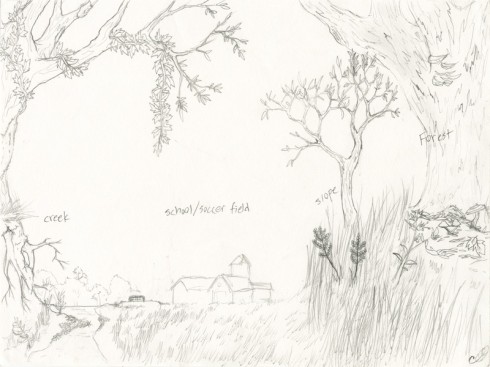
The plums are edible. They’re supposed to be good for pies and sauces. The Shaw Nature Center finds that these tall shrubs/small trees are a good sellers at their plant sales.
Propagation from seed is apparently a little tricky. The best way is to process them through the digestive system of a coyote. Alternatively, you have to let them ferment for a while to break down the outer coating of the seeds.
They would be a nice, native addition to our orchard.
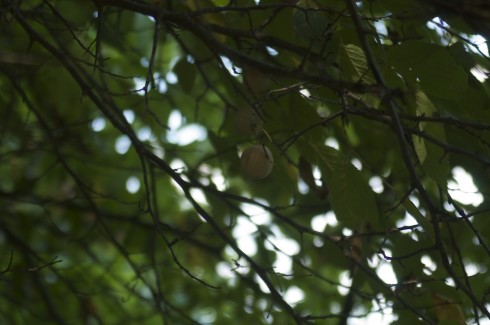
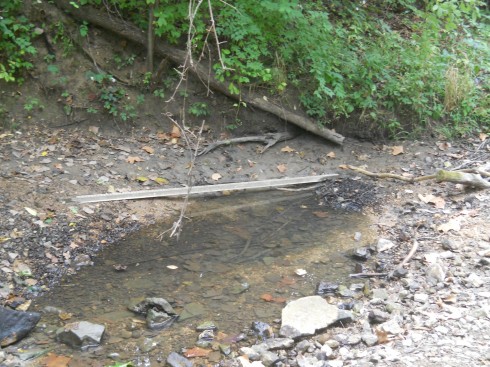
It has been remarkable to see the drying of the creek over the relatively dry summer.
Spring.
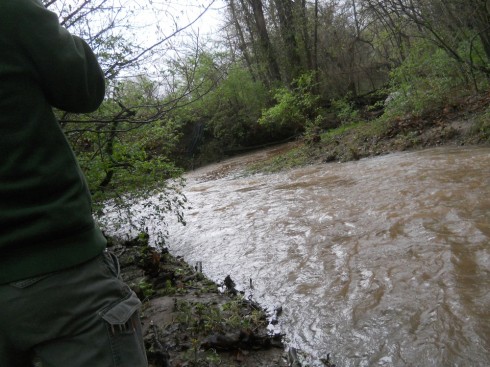
Mid-Summer
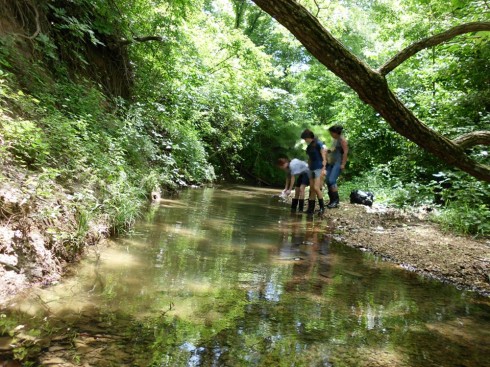
End of the summer.
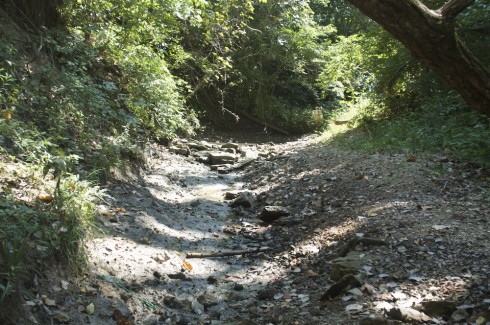
I had one of my middle school student groups try a conservation of momentum experiment that, while they made it out very well in the end, did not do a good job of conserving momentum.
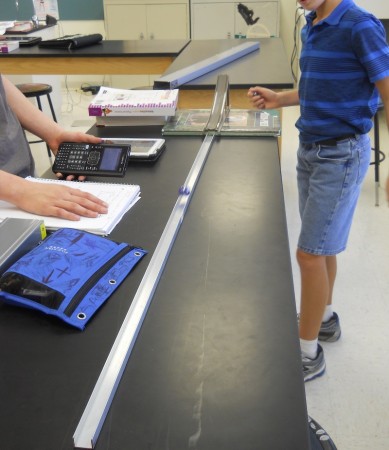
The students rolled a marble down a ramp by itself and measured its velocity across a horizontal track. The velocity measurement let them calculate the marble’s momentum across the track since they’d measured the mass of the marble before rolling it down the ramp:
momentum = mass x velocity
Note that since mass was measured in grams (g) and velocity in centimeters per second (cm/s), their units of momentum were gram-centimeters per second (g cm/s).
That was the easy part.
Next they put a second marble at the bottom of the ramp as a target, so the first marble would hit it and redistribute the momentum.
Because it was a collision between two marbles, there was no easy way to make the collision sticky, so they ended up with two marbles moving off at different speeds. Measuring the speeds of the two marbles at the same time was tricky, but they got it done.
Finally, they could calculate the momentum of the two marbles at the end, and the combined momentum should have been equal to the momentum of the one marble from before if momentum had been conserved.
When they did the math, the marbles after collision had about 80% of the momentum of the single marble. This difference allowed them to explain, in their presentation, that momentum was not completely conserved — and in real life it almost never is — because some energy was lost in the collision. Fortunately, we’d already had the presentation on friction so the context of energy losses, and resistive forces could be incorporated into the discussion.
I suspect that some significant portion of the difference in momentum measured was due to the fact that they were using stopwatches to measure the time the marbles took to move between two markers on the track. I’d love to have a motion detector or photogates for this experiment.
My students (almost) created an unmanned robotic drone for delivering messages to the main office.

The robotics students have put together their first robots and are trying out the software for making them move. Lego has a new app that allows you to use your iPhone or iPad as a remote control, and my kids love it. They’ve got a robot fighting competition going on using them as remotes. I, however, wanting to push them into actually programming the robots for autonomous motion, told them I wanted them to get the robot to deliver a message to the front office without them following it through the building.
Well, this was their solution:
They attached an iPhone to one of their robot with the camera facing out. They then connected made a video call to that phone using another phone and the FaceTime app. Since the two phones were busy communicating with each other, the robot was operated using the wireless, Bluetooth connection via someone else’s iPad.
It worked. More or less. The robot lost the Bluetooth connection at the end of the hall, so the robot could not make it all the way to the office.
So now they’re actually trying to write a program. Although I finally got them to do what I wanted, I have to say I was impressed with their innovative use of technology.
Scientific American has an article on “The Scientific Secret of Fluffy Pancakes” that nicely covers the chemistry of gluten. The article includes a recipe, but I tend to prefer buttermilk pancakes (Cook’s Illustrated has a great buttermilk pancake recipe that I find tastes even better if you leave out the sugar).
My wife has been experimenting with gluten-free pancakes and I’ve discovered that I like hers even better because of all the ground nuts it includes. However, in the gluten-free recipes, crucially, Xanthan gum is used to replace the gluten in capturing the carbon dioxide bubbles created by the baking powder reacting with the acid in the recipe. While the gluten is sensitive to how much the batter is mixed (stretching out the proteins), the quantity of Xanthan gum is more important in the gluten-free recipes.
↬ Maggie Eisenberger.